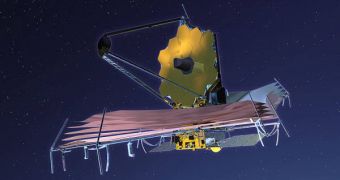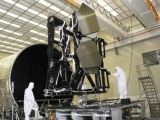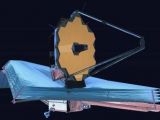NASA's planned James Webb Space Telescope, designated to succeed the aging Hubble, is currently under development, in a 15-nation collaboration, led by the Goddard Space Flight Center, in Greenbelt, Maryland. The Northrop Grumman Aerospace Systems is the main contractor for the construction, while Ball Aerospace & Technologies Corp. is the main optics subcontractor. The revolutionary telescope is a premier in many ways, and is especially important for NASA on account of the fact that it is the first telescope to be built with the goal of seeing the beginning of the Universe.
The infrared orbiting observatory is currently scheduled to be launched no early than June 2013, aboard an Ariane 5 delivery system. The rocket will most likely take off from the European Space Agency's Guiana Space Centre Kourou, in French Guiana, South America. It will operate in the 0.6 to 28 micrometre-wavelength range, in order to be able to peer through large amounts of cosmic dust and gases. Because of its infrared nature, the entire telescope will have to operate in a somewhat cool environment, at roughly 40°Kelvin (−233.15°C or −387.67°F).
In order for that to be possible, the observatory will be placed in an extreme orbit around the Sun, in the second Lagrangian point (L2). Basically, its orbit will be a lot further than the Moon, at a distance of about 1.5 million kilometers away from Earth. Regularly, celestial bodies that orbit the Sun at a distance greater than our planet accomplish a full rotation around the star in less than a year, but James Webb will be able to do so as fast as our planet, mostly because of the complicated characteristics of its orbit, where the gravity pull from the Sun and the Earth makes for a very steady orbit. This would allow for a minimum fuel consumption in thrusters, and for a designated 10-year lifespan.
The amazing new spacecraft will also seek to bring forth a new age of space knowledge, and scientists envision this happening in very much the same way Hubble revolutionized astronomy when it was first launched – through unexpected finds. James Webb will look for the light coming from the early Universe, will strive to understand how galaxies form and evolve, will seek to gain a better knowledge of how stars and planetary systems spring into existence, and will also attempt to study planetary systems and the origins of life.
Only recently, the observatory successfully passed its first cryogenic tests for the primary mirror, composed of 18 hexagonal segments, at the Marshall Space Flight Center's X-ray and Cryogenic Facility, in Huntsville, Alabama. “We're excited that we can support the James Webb Space Telescope with our world class cryogenic and x-ray telescope test facility. The test performed here are crucial to the success of the program since they'll ensure the mirrors and components will be able to withstand the extreme cold temperatures of space,” Webb Telescope activities Project Manager Helen Cole said.
“It has taken years of intense effort for the Webb Telescope team to begin flight mirror cryotesting and we're gratified that testing was successful. Along the way, we've had to invent entire manufacturing and measurement processes because no one has ever built a telescope this large that has to operate at temperatures this extreme,” Northrop Grumman's Aerospace Systems sector Webb telescope Program Manager Martin Mohan added.

 14 DAY TRIAL //
14 DAY TRIAL // 


